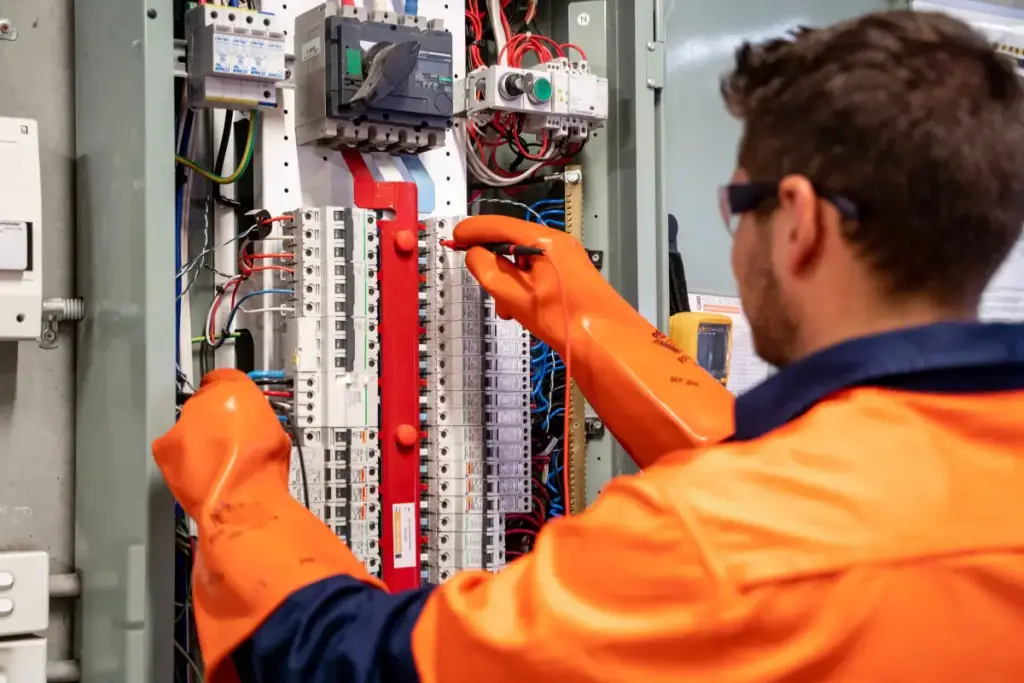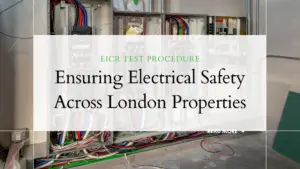An “EICR Test Procedure” is required to ensure the safety of electrical installations in London properties. It involves a thorough inspection conducted by qualified professionals who assess components such as wiring, circuit breakers, and connections, and perform tests, including measuring insulation resistance and earth fault loop impedance. Landlords must comply by providing tenants with these reports every 5 years to prevent electrical hazards and ensure tenant safety, which is critical to reducing legal liabilities and maintaining property values. For a deeper understanding of how an EICR can safeguard your property and the well-being of its occupants, explore further details on the detailed process and benefits.
Table of Contents
ToggleKey Takeaways
- Schedule an inspection with a qualified electrician registered with a competent person scheme.
- Ensure all electrical system areas are accessible and free from obstructions.
- Conduct detailed electrical tests, including measurements of earth fault loop impedance and insulation resistance.
- Review and prepare property electrical system drawings and previous EICR reports for the electrician.
- Compile an EICR report detailing defects, categorising them by risk level, and recommending necessary remedial actions.
What is an EICR, And Why Electrical Safety Matters for London Landlords
An Electrical Installation Condition Report (EICR) is a critical assessment used to evaluate the safety of electrical systems in properties. This examination is especially pivotal for London landlords, who are entrusted with the safety and well-being of their tenants.
The EICR serves as formal documentation that the property’s electrical systems are up to standard, potentially averting electrical hazards that could compromise tenant safety.
For landlords, the EICR is not just about compliance with legal standards but also about ensuring a secure living environment, which significantly enhances tenant satisfaction. The freedom to provide safe, appealing housing enables landlords to cultivate a positive reputation and maintain a high occupancy rate.
It also minimises the risk of electrical fires, which are a leading cause of property damage and personal injury in residential buildings.
By adhering to the guidelines and recommendations provided in an EICR, landlords not only comply with the law but also show tenant care.
The Purpose and Importance of an Electrical Installation Condition Report
The primary purpose of an Electrical Installation Condition Report (EICR) is to evaluate whether the fixed wiring, circuits, and electrical components meet current safety regulations and operate without risk to occupants.
The importance of an EICR lies in its ability to protect both people and property.
It provides assurance that a building’s electrical infrastructure is maintained to professional standards, safeguarding tenants and reducing potential liability for landlords.
Ultimately, an up-to-date EICR reflects a landlord’s or property manager’s commitment to safety and legal responsibility, reinforcing trust and confidence among tenants and stakeholders alike.

Legal Responsibilities of Landlords Under the EICR Regulations
In the UK, landlords are legally required to ensure that the electrical installations in their rental properties are safe throughout a tenancy. The key legislation governing this duty is the Electrical Safety Standards in the Private Rented Sector (England) Regulations 2020.
These regulations require landlords to have an Electrical Installation Condition Report (EICR) carried out by a qualified and competent electrician at least every 5 years, or sooner if recommended by the inspector.
An “EICR Test Procedure” must confirm that the electrical system complies with the BS 7671 – IET Wiring Regulations, which set the national standard for electrical safety. Landlords must provide a copy of the report to new tenants before they move in, to existing tenants within 28 days of the inspection, and to the local authority within seven days if requested.
Below is a table summarising the key components of the EICR regulations for landlords:
| Requirement | Description | Consequence of Non-compliance |
| Regular Testing | Electrical installations must be checked every 5 years. | Fines and potential prosecution |
| Qualified Professional | Only certified electricians can perform EICR tests. | Legal actions and fines |
| Documentation | A report must be provided to tenants within 28 days. | Penalties and tenant disputes |
Landlords must embrace these responsibilities, not as a burden, but as an opportunity to demonstrate their commitment to tenant safety and property standards. By adhering to these regulations, landlords not only comply with the law but also promote a culture of responsibility and safety that resonates throughout their properties.
Step-by-Step Guide to the EICR Test Procedure
Initiating an “EICR Test Procedure” involves several precise stages designed to ensure the safety and compliance of electrical systems within a property. Below is a breakdown of the process:
Scheduling the Inspection
- The process begins by booking an inspection with a qualified and registered electrician who is part of a recognised competent person scheme.
- Verifying credentials ensures compliance with UK electrical safety regulations.
Preliminary System Review
- The electrician reviews electrical drawings, records, or previous reports (if available) to understand the property’s electrical layout and history.
- This helps define the scope and focus of the inspection.
Visual Inspection of Installations
- The electrician performs a comprehensive visual check of all electrical components, including:
- Wiring condition and insulation
- Circuit breakers and fuses
- Consumer units and protective devices
- Areas showing wear, corrosion, or damage are flagged for further testing.
Electrical Testing
- A series of technical tests is conducted to identify hidden or potential faults, such as:
- Earth fault loop impedance tests
- Insulation resistance tests
- RCD (Residual Current Device) operation tests
- These checks confirm that each circuit is safe, correctly configured, and performs as intended.
Compilation of the EICR Report
- Once testing is complete, the electrician prepares the Electrical Installation Condition Report detailing:
- Any defects or non-compliance issues
- The severity codes (C1, C2, C3, or FI) assigned to each fault
- Recommended remedial actions to restore full safety compliance
Final Documentation and Follow-Up
- The completed report serves as both proof of inspection and a guide for corrective action.
- Landlords should retain the EICR for records and ensure all required repairs are completed promptly.
This document is both a record of the inspection and a guide for any required follow-up actions. Learn more about What will the EICR report show.
Common Electrical Faults Found in London Rental Properties
Even well-maintained properties can develop electrical issues over time. During an “EICR Test Procedure”, qualified electricians often identify recurring faults that compromise safety and compliance.
Below are some of the most common electrical problems found in London rental properties.
Wiring and Circuit Problems
EICR inspections often uncover damaged cables, loose terminations, and overloaded circuits. These faults increase the risk of short circuits or fires, especially in older London buildings. Early detection helps landlords fix issues before they become dangerous.
Faulty Sockets and Switches
Loose or cracked sockets and worn switches are frequent in rental homes. They may cause electric shocks or overheating. Regular EICR checks ensure these fittings are identified and replaced safely.
Overheating and Burn Marks
Black marks or melting around outlets signal overheating or loose wiring. These signs point to potential fire hazards. EICR testing helps locate and correct the cause quickly.
Outdated Consumer Units
Many older properties still have fuse boxes without RCD protection. RCDs cut power instantly during faults, preventing shocks. Upgrading to modern BS 7671-compliant units is essential for safety.
Earthing and Bonding Faults
Missing or weak earthing and bonding can make electrical systems unsafe. The EICR confirms whether metal fittings and pipework are properly connected and highlights any urgent fixes needed.
To emphasise the importance of addressing these issues, consider the following:
- Regular Maintenance: Routine checks can prevent the deterioration of electrical systems and guarantee compliance with safety standards.
- Upgrading Systems: Replacing old wiring and circuit components can enhance safety and accommodate modern electrical loads.
- Professional Assessments: Hiring qualified electricians to conduct thorough EICR tests can identify and rectify faults before they lead to serious consequences.
Guaranteeing that these steps are taken not only promotes safety but also empowers tenants to live in a secure, reliably powered environment.
Understanding EICR Codes: C1, C2, C3, and FI Explained
Building on the importance of identifying common electrical faults in London rental properties, it is equally important to understand how these issues are classified during an Electrical Installation Condition Report (EICR). This classification empowers both property owners and tenants with the knowledge and freedom to address electrical safety concerns proactively.
The EICR codes indicating the level of urgency and risk associated with the fault found.
Code C1, often considered the most urgent, signifies a ‘Danger Present’ situation where there is a risk of injury, and immediate remedial action is required. This code compels action without delay, guaranteeing that safety is restored with utmost priority.
Code C2 is labelled as ‘Potentially Dangerous’. This code suggests that urgent attention is needed, although the risk is not as immediate as C1. Property owners are advised to address C2 issues promptly to prevent escalation into more severe problems.
Code C3 denotes ‘Improvement Recommended’. This code does not imply immediate or potential danger but highlights areas where improvements would enhance the overall safety and efficiency of the electrical installation. Addressing these issues is advisable but not compulsory.
Lastly, the FI code stands for ‘Further Investigation Required’. This indicates that an anomaly has been detected, warranting further analysis to assess the level of risk or fault. Timely investigation following an FI code is essential to determine the necessary corrective actions and maintain ongoing safety.
Understanding these codes allows property owners and residents to manage and prioritise electrical safety, ensuring a secure living environment.
How to Prepare Your Property for an EICR Inspection
Preparing your property for an “EICR Test Procedure” is a critical step for guaranteeing the safety and compliance of your electrical systems.
This process not only helps identify potential electrical safety risks but also ensures your property complies with current regulatory standards, providing peace of mind and enhancing its value.
To facilitate a smooth, efficient inspection, several preparatory measures are recommended.
These preparations not only assist the electrician in conducting a thorough assessment but also help avoid potential disruptions during the process.
- Access: Confirm that all areas with electrical systems, including service rooms, basements, and attics, are easily accessible.
Remove any obstructions that might hinder the inspector’s access to electrical panels, outlets, and installed fixtures.
- Documentation: Gather all relevant documents about your property’s electrical installations.
This includes previous EICR reports, details of any modifications made to the electrical system, and records of repairs and maintenance.
Having these documents on hand can significantly expedite the inspection process.
- Operational Status: Verify that the power supply is functional and all areas of the property are receiving electricity.
Non-working outlets or circuits can indicate underlying issues that need immediate attention during the inspection.

Benefits of Routine Electrical Testing for Landlords and Tenants
Landlords benefit considerably, as consistent compliance with safety standards can reduce insurance premiums and liability claims.
For tenants, routine electrical testing guarantees that the electrical systems in their residences meet the required safety standards, providing peace of mind. It dramatically reduces the risk of electrical fires, shocks, and other hazardous incidents that could lead to severe injuries or fatalities.
Knowing that their home environment is routinely checked and maintained allows tenants to live more freely, without the worry of unforeseen electrical failures.
Moreover, regular checks can identify potential problems before they escalate into costly repairs. Early detection of faults in wiring, sockets, and other electrical components can lead to immediate fixes, guaranteeing the property remains in prime condition.
In essence, routine electrical testing is a cornerstone of residential safety and maintenance. An “EICR Test Procedure” is a critical practice that supports tenants’ well-being and protects landlords’ financial and legal interests, embodying a proactive step towards a secure, undisturbed living experience.
How Often Should an EICR Be Renewed
The frequency of renewing an Electrical Installation Condition Report (EICR) depends on various factors, including the type of property, its use, and the age of the installation.
For residential properties, it is generally recommended that an EICR be conducted every five years or with each change of occupancy. This guarantees that all electrical installations are safe for new tenants to use and helps prevent potential hazards.
Several specific factors can influence the urgency and frequency of these tests:
- The age of the electrical installation: Older installations may require more frequent checks.
- The type of property: Commercial buildings generally need more regular inspections than residential properties.
- Evidence of previous faults: Properties with a history of electrical issues may benefit from more frequent testing.
Why Choose the Landlord Safety Certificate for Reliable EICR Testing
Landlord Safety Certificate is distinguished by its team of certified and experienced electricians. Each technician is meticulously trained and possesses an in-depth understanding of the latest electrical safety regulations.
This expertise assures landlords that their properties are inspected rigorously and any potential electrical hazards are identified and addressed proficiently.
Moreover, Landlord Safety Certificate values transparency and communication. Clients receive detailed, easy-to-understand reports that confirm property owners can make informed decisions about their electrical systems.
Another significant advantage of choosing us is our adaptability to client schedules and specific needs. They offer flexible scheduling options that allow property owners to arrange inspections
Frequently Asked Questions
Can Tenants Request an EICR Test Independently?
Tenants can request an independent EICR test to guarantee their living environment meets safety standards. This proactive approach empowers them to safeguard their well-being and maintain peace of mind regarding electrical hazards.
Are There Exemptions for Newer Properties From EICR Requirements?
Newer properties may be exempt from EICR requirements if they hold a valid Electrical Installation Certificate that demonstrates compliance with the latest wiring regulations since their construction or their last major electrical work.
What Happens if a Landlord Ignores EICR Obligations?
If a landlord disregards EICR obligations, they risk legal penalties, including fines and potential restrictions on property rental. Compliance is essential to guarantee tenant safety and maintain lawful property management standards.
Do EICR Requirements Differ Across Various London Boroughs?
EICR requirements are standardised across all London boroughs, ensuring uniform safety protocols and compliance. This consistency supports landlords’ freedom to manage properties without varying local regulations complicating electrical safety obligations.
Can a Failed EICR Impact Property Insurance Rates?
Yes, a failed Electrical Installation Condition Report (EICR) can increase property insurance rates. Insurers may view electrical deficiencies as heightened risks, leading to adjustments in policy costs to mitigate them.
Conclusion
To summarise, the “EICR Test Procedure” is a tool for ensuring electrical safety in London rental properties, safeguarding the interests of both landlords and tenants. Regular compliance with EICR regulations not only fulfils legal obligations but also promotes a secure living environment. Landlords are advised to engage reliable service providers for periodic assessments to enhance property value and tenant safety. Adherence to these practices is essential for maintaining high safety standards in the residential rental sector.




